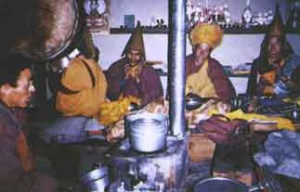Shamanism in the High Snows: The Chhowas and Tantrik Healers of Spirit
A pilot project sponsored by IGNCA was undertaken by Shirish Jain, a Research Scholar in the Department of Sociology, Delhi University. Here we present a brief excerpt from his report.
A very pluralistic type of milieu exists in Spiti in healing practices or Shamanism. The people here are devout Buddhists, with almost each family traditionally sending one or more of their sons to the monasteries at an early age to join the lamaistic order. Various sects of the Tibetan Buddhist religion are found prevalent, including the gelugpa (Yellow Hat Sect) nyingmapa and sakya. The chhowa tradition seems to be a product of the pre-Buddhist era, indigenous to this region.
As is the case with mainstream Tibetan Buddhism, here too the religious and healing arenas are completely intertwined and indistinguishable. The Tibetan system of healing is practised by local traditional Tibetan doctors known as amchis or imchis. They have a thorough knowledge of herbal treatment and the use of local herb preparations for most of the ailments. However, when a patient is deemed to be ‘serious’ by the family and community members, recourse is taken from the lamaistic healers in the monasteries. Invariably the lamas are invited to the homes of the afflicted, rather than the patients going to the monasteries themselves.
Adding to the complexity of the situation is the introduction of government hospitals and dispensaries by the state and central governments in the last few decades. The norm in present time is that the people do avail the bio-medical facilities in these modern medical institutions, but they always complement the treatment with a visit to a local imchi or an invitation to the lamas of the nearest gompa (monastery). Most of the rituals and ceremonies are conducted during winter when people are not occupied with agriculture, trade and transport and now tourism-related activities. Theoretically, a healing ceremony is intended not only for the individual but for the well being of the entire community (and at the farthest level of abstraction for all sentinel beings as a whole). The effigies of the spirits known as torma are basically models of the local spirits and tantrik deities, such as wundo, dunkthor, chido, chintor, kangtor and shintak torma. These deities roughly correspond to the devtas revered in neighbouring Kinnaur in the Quasi-Hindu tantrik tradition as Mahakala, Kalidevi, Kalarupa, Visharwana and Rhamoprana. These models are basically made of sattu dough (tsampa) and barley. They are deep red in colour which is obtained from the locally abundant rattan-jyot or tsharma grass.
On the final day of the tantrik dzogchen healing ceremony, all the tormas are carried out from the house where the ceremony is performed in a special sacred spot outside the village where the evil spirits are symbolically destroyed. The tormas are then carried in a very colourful and large procession, with all the village children running after it excitedly. The lamas don their full tantrik costumes, replete with red robes and yellow hats. A flag bearer leads the procession bearing a flag depicting bhoti (Tibetan) name of Kalimata ‘jyo’. The rear is led by a band of local musicians belonging to the harijan caste, known as zho andbetha. The zho play the percussion, while the betha play the pipe/wind instruments.
At dusk the entire village community assemble at the sacred spot to witness the final ritual. After chanting and offering prayer, the head lama hurls the tormas into the fire one by one with very dramatic gestures accompanied by joyous shouts from the bystanders. The main effigy, called saur is symbolically destroyed by the head lama with different types of weapons, such as bow, arrow, axe, hammer and knives. The ceremony is followed by festivities, with local brews like chhaang and araak being consumed liberally. A huge feast, mainly consisting of yak meat (zha) preparation is offered by the host, in whose house the ceremony is performed. The lamas eat separately first followed by the guests from the community and finally the host’s family along with the local musicians and helpers.
In another ceremony, a ritual is performed to identify and also to get rid of the evil influences. On one occassion a ritual was performed by a family where the lady of the house delivered babies who lived only for a few months. During this kind of ritual the chhowa, local healer lights a fire in front of him. The ceremony begins with long periods of chanting and musical accompaniment. Dressed in an elaborate colourful silk robe and pointed hat, the chhowa performed the ritual as the percussion gathered momentum. He poured various offerings into the fire, such as dry fruits, barley grains, rice, wood, oil and different types of herbs. After a while he rendered a long high pitched and melodiously haunting song which had a mesmeric effect on everyone present. This was the moment of communication with the spirit which was causing problem. As the song came to an end, a hush fell over the spectators. A possessed individual with contorted face appeared before the altar screaming unclear words. Chhowa held up a paper which contained all the affliction caused by the spirit. This then was hurled into the fire followed by some special oil, which caused a loud explosion. The ceremony came to an end with the possessed person stamping out the fire bare-foot and rushing out of the scene. Thus vanquishing the spirit.
Other than these healing rituals, groups of tantrik lamas known as the bhuchen wander from village to village in winter, performing a variety of miraculous feats, dance dramas, singing songs and displaying weaponry with the intention of promoting faith and well-being among the inhabitants of the area.
[ Newsletter | List of Newsletter ]






